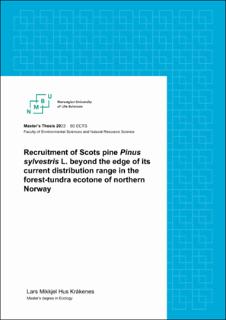| dc.description.abstract | The forest-tundra ecotone in Northern Fennoscandia has experienced significant abiotic and biotic changes in recent decades which may ultimately affect the distribution of tree species. In this study, I investigate the factors influencing the density and distribution of Scots pine at the northern distribution range to assess the potential for spread northwards. The study area covered three selected regions in northern Norway (west, south and east), each represented by two survey sites: one placed well within the current distribution of pine (‘core’ sites) and one placed at the leading edge of the current distribution (‘edge’ sites). In all sites combined, data on a total of 146 seed trees and 1642 recruits were collected. Three GLM models were fitted, looking at the regional differences in recruit density, the underlying local conditions that contribute to this variation, and the factors that influence effective dispersal distance from the seed tree.
The main results showed that; 1. There was generally lower recruitment at the leading edge of the distribution range, although this was not the case for the south region. 2. Recruit density decreased rapidly with the distance from the seed tree, even at the relatively short sampling distance. 3. Of the seed tree attributes, crown diameter was the only significant predictor, and positively influenced recruit density. 4. The proxy for graminoid abundance was the single significant predictor among the vegetation and soil variables and had a negative effect on recruit density. 5. Reindeer presence, as indicated by pellet density, negatively influenced recruit density, while moose presence showed a tendency for the opposite effect. 6. Birch density and stem diameter negatively influenced recruit density.
In conclusion, warming can be expected to facilitate the recruitment and expansion of Scots pine, possibly aided by reduced competition with birch due to moth outbreaks. However, the rate of expansion may be limited by short dispersal distances from the seed tree, and extreme weather events related to climate change. The large amount of unexplained variation signifies the complex influences on tree recruitment. Future studies should consider the influences of microclimate, biotic interactions, and microsites, to make robust forecasts of climate change effects on tree recruitment. | |
